Nonintrusive Load Monitoring Using Recurrent Neural Networks with Occupants Location Information in Residential Buildings
Abstract
1. Introduction
2. Literature Review
2.1. Occupant Localization Approach
2.2. Nonintrusive Load Monitoring Approach
2.2.1. Factorial Hidden Markov Model
2.2.2. NILM with Nonelectric Information
3. Methods
3.1. Experimental Setting and Data Collection
3.2. Recurrent Neural Networks
3.2.1. Long Short-Term Memory
3.2.2. Gated Recurrent Units
3.3. Occupant Localization Based on Image Data
3.3.1. Convolution Neural Networks
3.3.2. Occupant Detection and Image Processing
4. Results and Discussion
4.1. Experimental Cases
4.2. Performance Metrics
4.3. Design of Energy Disaggregation Model
4.4. Optimization of Hyper-Parameters
4.5. Results
4.5.1. Performance of Electricity Consumption Disaggregation
4.5.2. Performance of Appliance State Estimation
4.5.3. Effect of Occupant Location Information
5. Conclusions
Author Contributions
Funding
Data Availability Statement
Conflicts of Interest
References
- Energy Information Administration. International Energy Outlook 2019 (IEO2019); Energy Information Administration: Washington, DC, USA, 2019; Volume 26. [Google Scholar]
- Korea Energy Economics Institute. Monthly Energy Statistics (2019.04); Korea Energy Economics Institute: Ulsan, Republic of Korea, 2019. [Google Scholar]
- Kolter, J.Z.; Johnson, M.J. REDD: A Public Data Set for Energy Disaggregation Research. In Proceedings of the Workshop on Data Mining Applications in Sustainability (SIGKDD), San Diego, CA, USA, 21–24 August 2011; No. Citeseer. Volume 25, pp. 59–62. [Google Scholar]
- Darby, S. The effectiveness of feedback on energy consumption. A Rev. DEFRA Lit. Metering Billing Direct Disp. 2006, 486, 26. [Google Scholar]
- Ghahramani, Z.; Jordan, M.I. Factorial hidden Markov models. Mach. Learn. 1997, 29, 245–273. [Google Scholar] [CrossRef]
- Kim, J.; Le, T.T.H.; Kim, H. Nonintrusive load monitoring based on advanced deep learning and novel signature. Comput. Intell. Neurosci. 2017, 2017, 4216281. [Google Scholar] [CrossRef] [PubMed]
- Bhotto, M.Z.A.; Makonin, S.; Bajić, I.V. Load Disaggregation Based on Aided Linear Integer Programming. IEEE Trans. Circuits Syst. II Express Briefs 2016, 64, 792–796. [Google Scholar] [CrossRef]
- Balletti, M.; Piccialli, V.; Sudoso, A.M. Mixed-Integer Nonlinear Programming for State-Based Non-Intrusive Load Monitoring. IEEE Trans. Smart Grid 2021, 13, 3301–3314. [Google Scholar] [CrossRef]
- Gul, M.S.; Patidar, S. Understanding the energy consumption and occupancy of a multi-purpose academic building. Energy Build. 2015, 87, 155–165. [Google Scholar] [CrossRef]
- Martani, C.; Lee, D.; Robinson, P.; Britter, R.; Ratti, C. ENERNET: Studying the dynamic relationship between building occupancy and energy consumption. Energy Build. 2012, 47, 584–591. [Google Scholar] [CrossRef]
- Rafsanjani, H.N.; Ahn, C.R.; Chen, J. Linking building energy consumption with occupants’ energy-consuming behaviors in commercial buildings: Non-intrusive occupant load monitoring (NIOLM). Energy Build. 2018, 172, 317–327. [Google Scholar] [CrossRef]
- Hosseini, S.; Kelouwani, S.; Agbossou, K.; Cardenas, A.; Henao, N. A Semi-Synthetic Dataset Development Tool for Household Energy Consumption Analysis. In Proceedings of the 2017 IEEE International Conference on Industrial Technology (ICIT), Ontario, CA, USA, 22–25 March 2017; pp. 564–569. [Google Scholar]
- Holmegaard, E.; Kjærgaard, M.B. NILM in an Industrial Setting: A Load Characterization and aAlgorithm Evaluation. In Proceedings of the 2016 IEEE International Conference on Smart Computing (SMARTCOMP), St. Louis, MO, USA, 18–20 May 2016; pp. 1–8. [Google Scholar]
- Hüsken, M.; Stagge, P. Recurrent neural networks for time series classification. Neurocomputing 2003, 50, 223–235. [Google Scholar] [CrossRef]
- Akkaya, K.; Guvenc, I.; Aygun, R.; Pala, N.; Kadri, A. IoT-Based Occupancy Monitoring Techniques for Energy-Efficient Smart Buildings. In Proceedings of the 2015 IEEE Wireless Communications and Networking Conference Workshops (WCNCW), New Orleans, LA, USA, 9–12 March 2015; pp. 58–63. [Google Scholar]
- Diraco, G.; Leone, A.; Siciliano, P. People occupancy detection and profiling with 3D depth sensors for building energy management. Energy Build. 2015, 92, 246–266. [Google Scholar] [CrossRef]
- Uotila, V.; Skogster, P. Space management in a DIY store analyzing consumer shopping paths with data-tracking devices. Facilities 2007, 25, 363–374. [Google Scholar] [CrossRef]
- Paolini, G.; Del Prete, M.; Berra, F.; Masotti, D.; Costanzo, A. An Agile and Accurate Microwave System for Tracking Elderly People Occupancy at Home. In Proceedings of the 2016 IEEE MTT-S Latin America Microwave Conference (LAMC), Puerto Vallarta, Mexico, 12–14 December 2016; pp. 1–3. [Google Scholar]
- Mirshekari, M.; Pan, S.; Fagert, J.; Schooler, E.M.; Zhang, P.; Noh, H.Y. Occupant localization using footstep-induced structural vibration. Mech. Syst. Signal Process. 2018, 112, 77–97. [Google Scholar] [CrossRef]
- Henry, P.; Krainin, M.; Herbst, E.; Ren, X.; Fox, D. RGB-D mapping: Using Kinect-style depth cameras for dense 3D modeling of indoor environments. Int. J. Robot. Res. 2012, 31, 647–663. [Google Scholar] [CrossRef]
- Liu, S.; Yin, L.; Ho, W.K.; Ling, K.V.; Schiavon, S. A tracking cooling fan using geofence and camera-based indoor localization. Build. Environ. 2017, 114, 36–44. [Google Scholar] [CrossRef]
- Drira, S.; Reuland, Y.; Pai, S.G.; Noh, H.Y.; Smith, I.F. Model-based occupant tracking using slab-vibration measurements. Front. Built Environ. 2019, 5, 63. [Google Scholar] [CrossRef]
- Moussa, M.; Youssef, M. Smart Devices for Smart Environments: Device-Free Passive Detection in Real Environments. In Proceedings of the 2009 IEEE International Conference on Pervasive Computing and Communications, Galveston, TX, USA, 9–13 March 2009; pp. 1–6. [Google Scholar]
- Youssef, M.; Mah, M.; Agrawala, A. Challenges: Device-Free Passive Localization for Wireless Environments. In Proceedings of the 13th Annual ACM International Conference on Mobile Computing and Networking, Montreal, QC, Canada, 9–14 September 2007; pp. 222–229. [Google Scholar]
- Zhen, Z.N.; Jia, Q.S.; Song, C.; Guan, X. An indoor localization algorithm for lighting control using RFID. In Proceedings of the 2008 IEEE Energy 2030 Conference, Atlanta, GA, USA, 17–18 November 2008; pp. 1–6. [Google Scholar]
- Chintalapudi, K.; Padmanabha Iyer, A.; Padmanabhan, V.N. Indoor Localization without the Pain. In Proceedings of the 16th Annual International Conference on Mobile Computing and Networking, Chicago, IL, USA, 20–24 September 2010; pp. 173–184. [Google Scholar]
- Anderson, K.D.; Bergés, M.E.; Ocneanu, A.; Benitez, D.; Moura, J.M. Event Detection for Non-intrusive Load Monitoring. In Proceedings of the IECON 2012-38th Annual Conference on IEEE Industrial Electronics Society, Montreal, CA, USA, 25–28 October 2012; pp. 3312–3317. [Google Scholar]
- Zeifman, M.; Roth, K. Nonintrusive appliance load monitoring: Review and outlook. IEEE Trans. Consum. Electron. 2011, 57, 76–84. [Google Scholar] [CrossRef]
- Hart, G.W. Nonintrusive appliance load monitoring. Proc. IEEE 1992, 80, 1870–1891. [Google Scholar] [CrossRef]
- Powers, J.T.; Margossian, B.; Smith, B.A. Using a rule-based algorithm to disaggregate end-use load profiles from premise-level data. IEEE Comput. Appl. Power 1991, 4, 42–47. [Google Scholar] [CrossRef]
- Laughman, C.; Lee, K.; Cox, R.; Shaw, S.; Leeb, S.; Norford, L.; Armstrong, P. Power signature analysis. IEEE Power Energy Mag. 2003, 1, 56–63. [Google Scholar] [CrossRef]
- Akbar, M.; Khan, Z.A. Modified Nonintrusive Appliance Load Monitoring for Nonlinear Devices. In Proceedings of the 2007 IEEE International Multitopic Conference, Lahore, Pakistan, 28–30 December 2007; pp. 1–5. [Google Scholar]
- Batra, N.; Wang, H.; Singh, A.; Whitehouse, K. Matrix Factorization for Scalable Energy Breakdown. In Proceedings of the AAAI Conference on Artificial Intelligence, New York, NY, USA, 4–9 February 2017. [Google Scholar]
- Yue, H.; Yan, K.; Zhao, J.; Ren, Y.; Yan, X.; Zhao, H. Estimating Demand Response Flexibility of Smart Home Appliances via NILM Algorithm. In Proceedings of the 2020 IEEE 4th Information Technology, Networking, Electronic and Automation Control Conference (ITNEC), Chongqing, China, 1 June 2020; pp. 394–398. [Google Scholar]
- Zoha, A.; Gluhak, A.; Imran, M.A.; Rajasegarar, S. Non-intrusive load monitoring approaches for disaggregated energy sensing: A survey. Sensors 2012, 12, 16838–16866. [Google Scholar] [CrossRef]
- Abubakar, I.; Khalid, S.N.; Mustafa, M.W.; Shareef, H.; Mustapha, M. Application of load monitoring in appliances’ energy management—A review. Renew. Sustain. Energy Rev. 2017, 67, 235–245. [Google Scholar] [CrossRef]
- Cypriano, J.G.; Juca, J.L.; da Silva, L.C.; Azzini, H.A. Load Disaggregation Development Project: A NILM Proposal for Energy Usage Changes. In Proceedings of the Applied Energy Symposium, MIT A+B, Boston, MA, USA, 22–24 May 2019; Available online: https://www.energy-proceedings.org/wp-content/uploads/2020/01/AEAB2019_paper_241.pdf (accessed on 1 May 2022).
- Kim, H.; Marwah, M.; Arlitt, M.; Lyon, G.; Han, J.; Society for Industrial and Applied Mathematics. Unsupervised Disaggregation of Low-Frequency Power Measurements. In Proceedings of the 2011 SIAM International Conference on Data Mining, Mesa, AZ, USA, 28–30 April 2011; pp. 747–758. [Google Scholar]
- Zeifman, M.; Roth, K. Disaggregation of Home Energy Display Data Using a Probabilistic Approach. In Proceedings of the 2012 IEEE International Conference on Consumer Electronics (ICCE), Las Vegas, NV, USA, 13–16 January 2012; pp. 630–631. [Google Scholar]
- Joo, I.T.; Choi, S.H. Stock Prediction Model based on Bidirectional LSTM Recurrent Neural Network. J. Korea Inst. Inf. Electron. Commun. Technol. 2018, 11, 204–208. [Google Scholar]
- Hochreiter, S. The vanishing gradient problem during learning recurrent neural nets and problem solutions. Int. J. Uncertain. Fuzziness Knowl.-Based Syst. 1998, 6, 107–116. [Google Scholar] [CrossRef]
- Hochreiter, S.; Schmidhuber, J. Long short-term memory. Neural Comput. 1997, 9, 1735–1780. [Google Scholar] [CrossRef] [PubMed]
- Cho, K.; Van Merriënboer, B.; Gulcehre, C.; Bahdanau, D.; Bougares, F.; Schwenk, H.; Bengio, Y. Learning phrase representations using RNN encoder-decoder for statistical machine translation. arXiv 2014, arXiv:1406.1078. [Google Scholar]
- Valueva, M.V.; Nagornov, N.N.; Lyakhov, P.A.; Valuev, G.V.; Chervyakov, N.I. Application of the residue number system to reduce hardware costs of the convolutional neural network implementation. Math. Comput. Simul. 2020, 177, 232–243. [Google Scholar] [CrossRef]
- Eom, Y.H.; Yoo, J.W.; Hong, S.B.; Kim, M.S. Refrigerant charge fault detection method of air source heat pump system using convolutional neural network for energy saving. Energy 2019, 187, 115877. [Google Scholar] [CrossRef]
- Redmon, J.; Farhadi, A. Yolov3: An incremental improvement. arXiv 2018, arXiv:1804.02767. [Google Scholar]
- Willmott, C.J.; Matsuura, K. Advantages of the mean absolute error (MAE) over the root mean square error (RMSE) in assessing average model performance. Clim. Res. 2005, 30, 79–82. [Google Scholar] [CrossRef]
- Chai, T.; Draxler, R.R. Root mean square error (RMSE) or mean absolute error (MAE)?–Arguments against avoiding RMSE in the literature. Geosci. Model Dev. 2014, 7, 1247–1250. [Google Scholar] [CrossRef]
- Willmott, C.J. Some comments on the evaluation of model performance. Bull. Am. Meteorol. Soc. 1982, 63, 1309–1313. [Google Scholar] [CrossRef]
- Batra, N.; Kelly, J.; Parson, O.; Dutta, H.; Knottenbelt, W.; Rogers, A.; Singh, A.; Srivastava, M. NILMTK: An Open Source Toolkit for Non-intrusive Load Monitoring. In Proceedings of the 5th International Conference on Future Energy Systems, Cambridge, UK, 11–13 June 2014; pp. 265–276. [Google Scholar]
- Kohavi, R. A Study of Cross-Validation and Bootstrap for Accuracy Estimation and Model Selection. In Proceedings of the International Joint Conference on Artificial Intelligence, Montreal, QC, Canada, 20–25 August 1995; pp. 1137–1145. [Google Scholar]
- Hsu, C.W.; Chang, C.C.; Lin, C.J. A Practical Guide to Support Vector Classification; Tech. Rep.; Department of Computer Science, National Taiwan University: Taipei City, Taiwan, 2003. [Google Scholar]


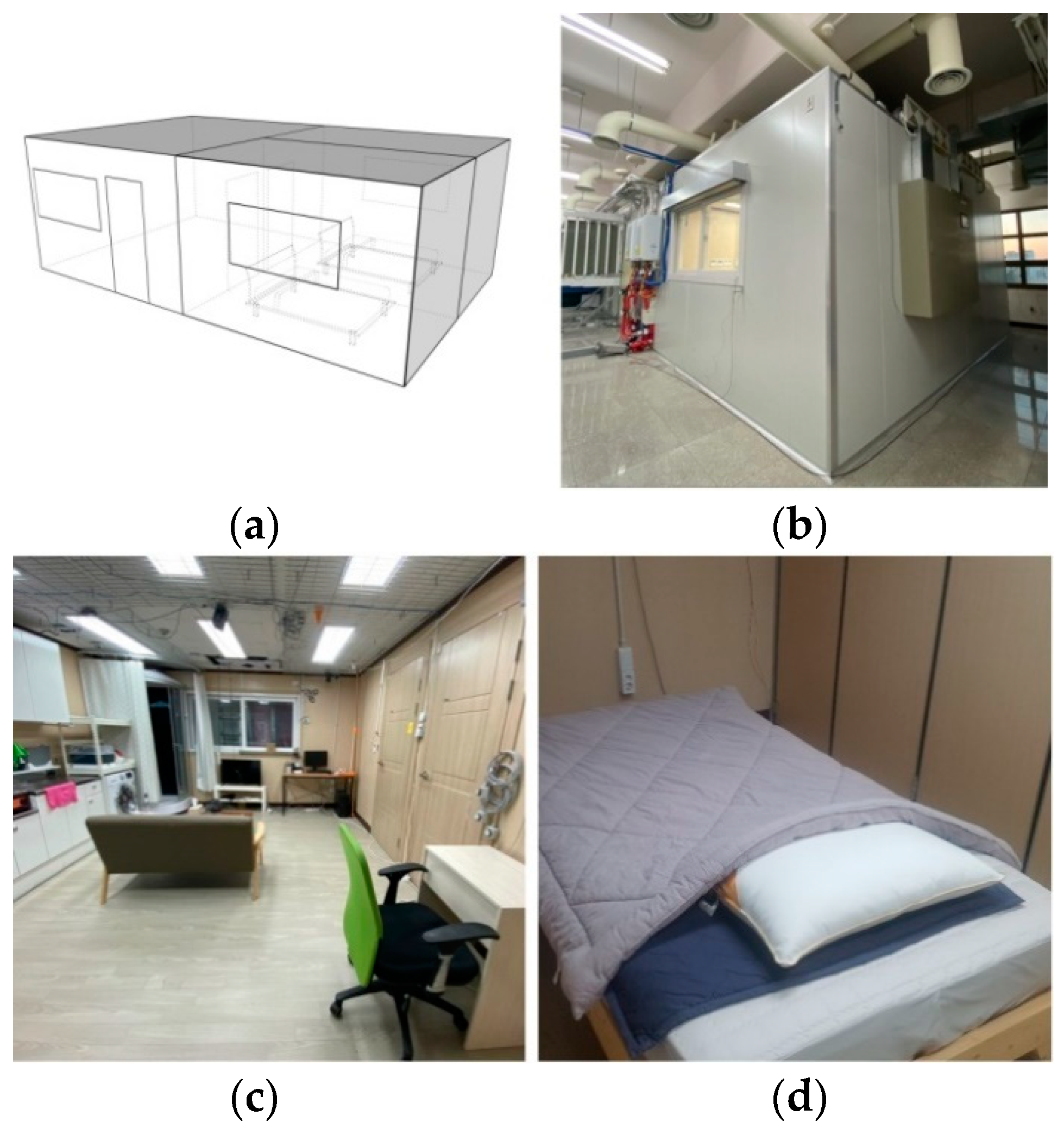
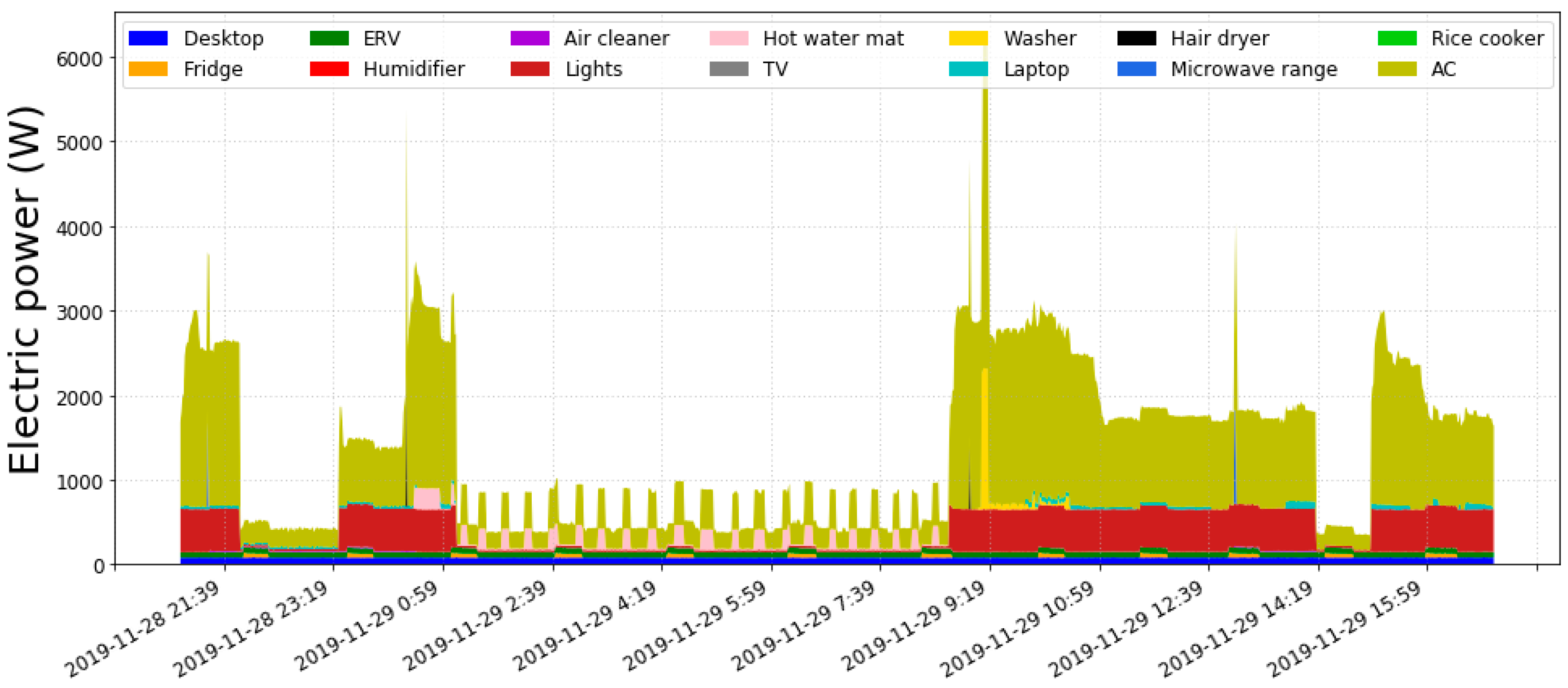
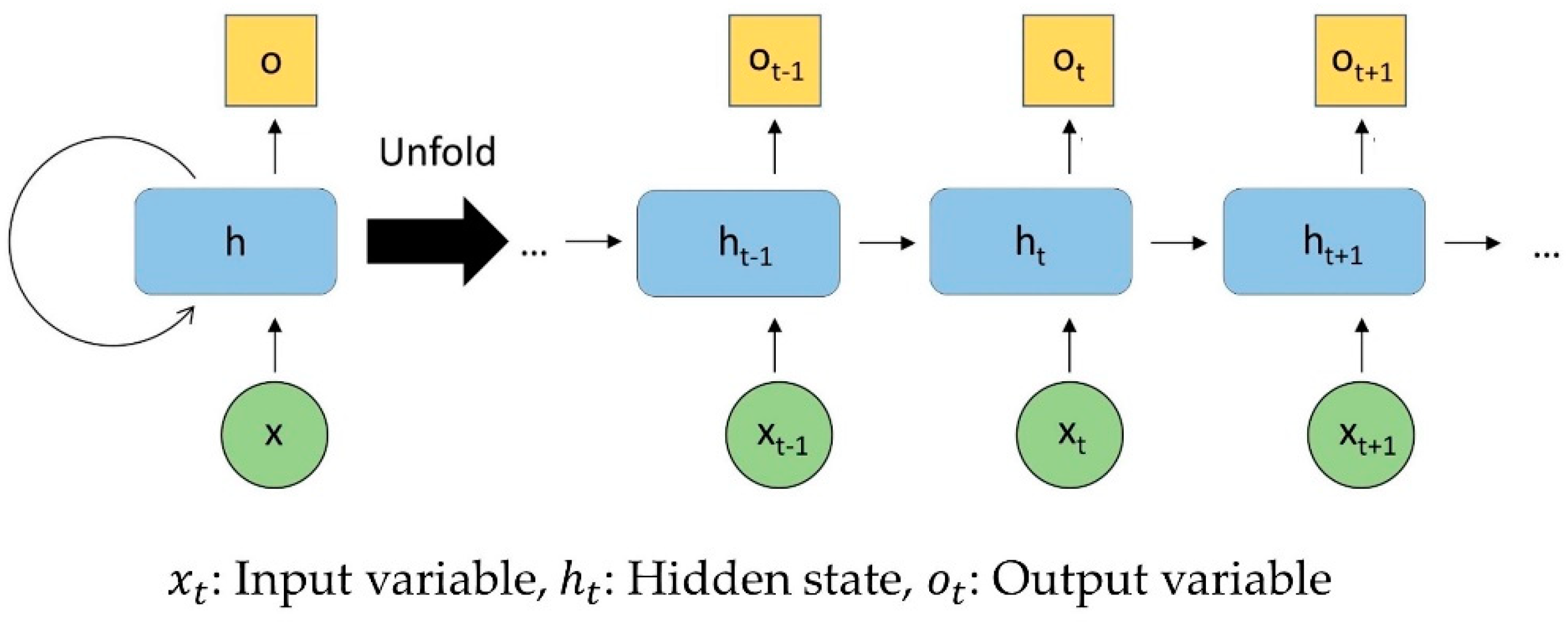
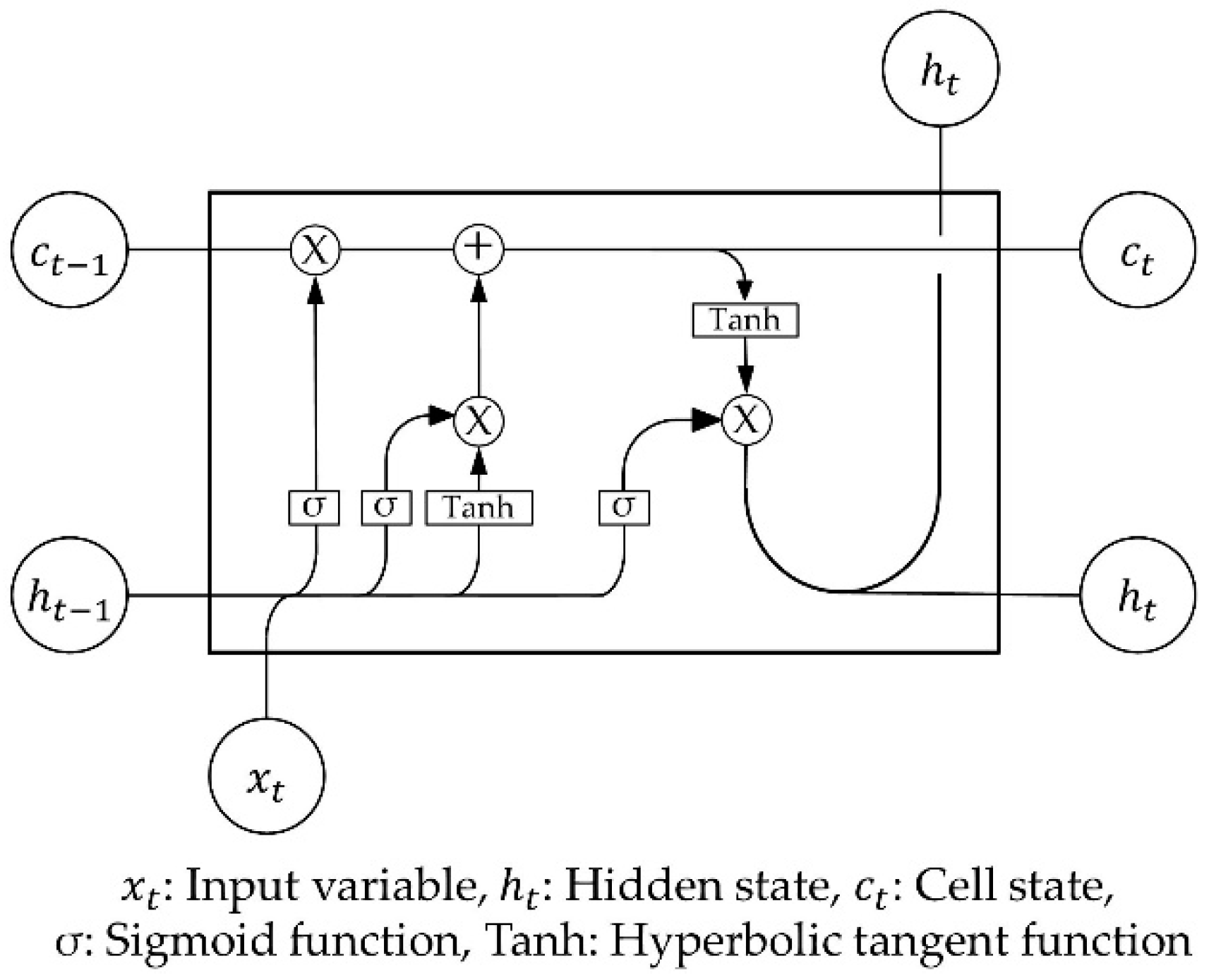
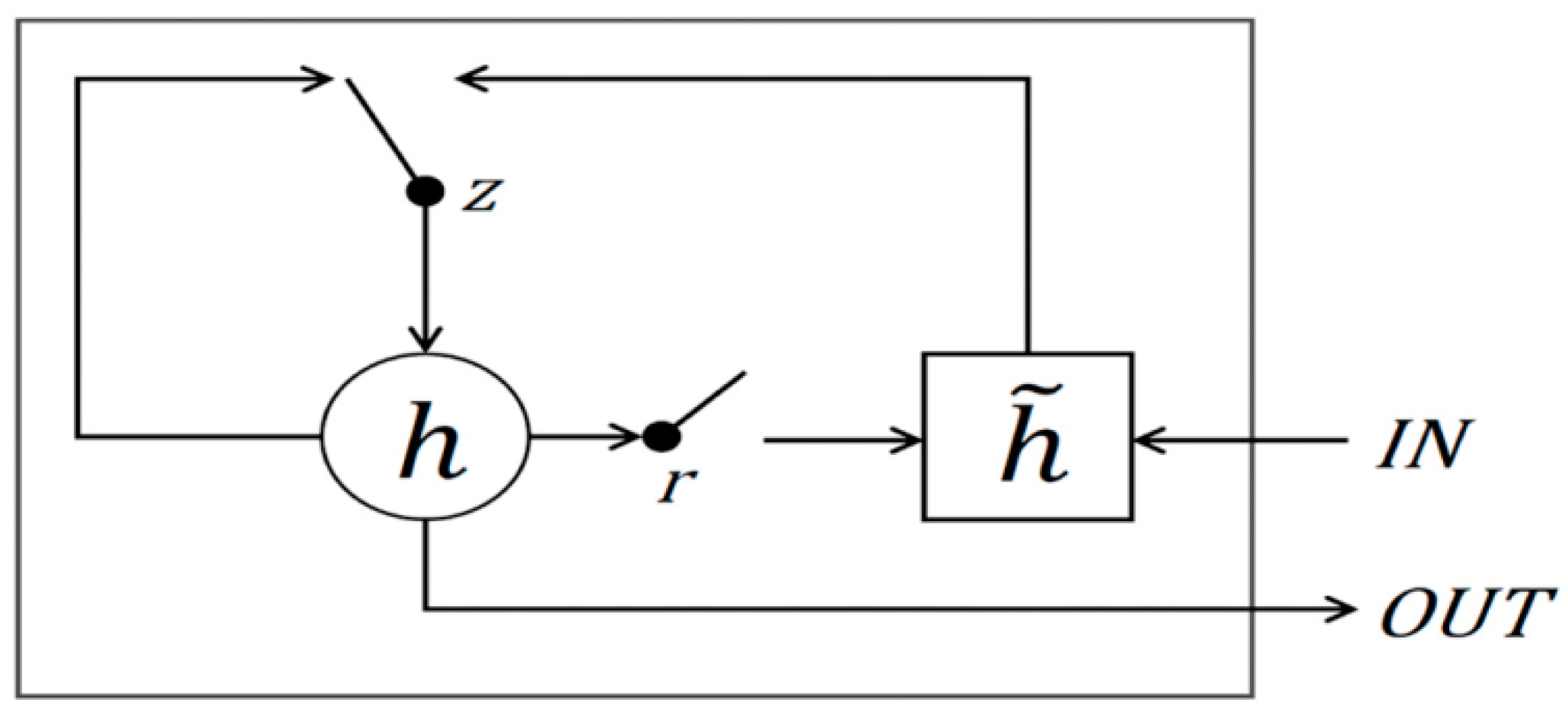
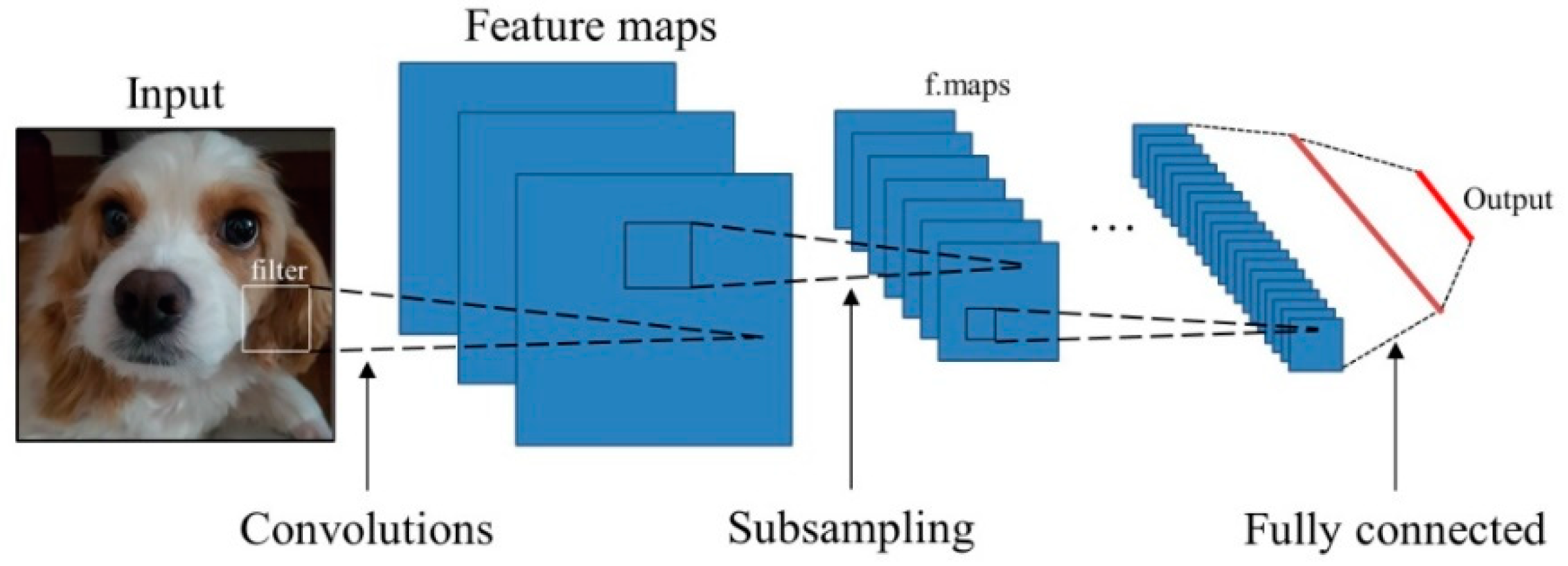
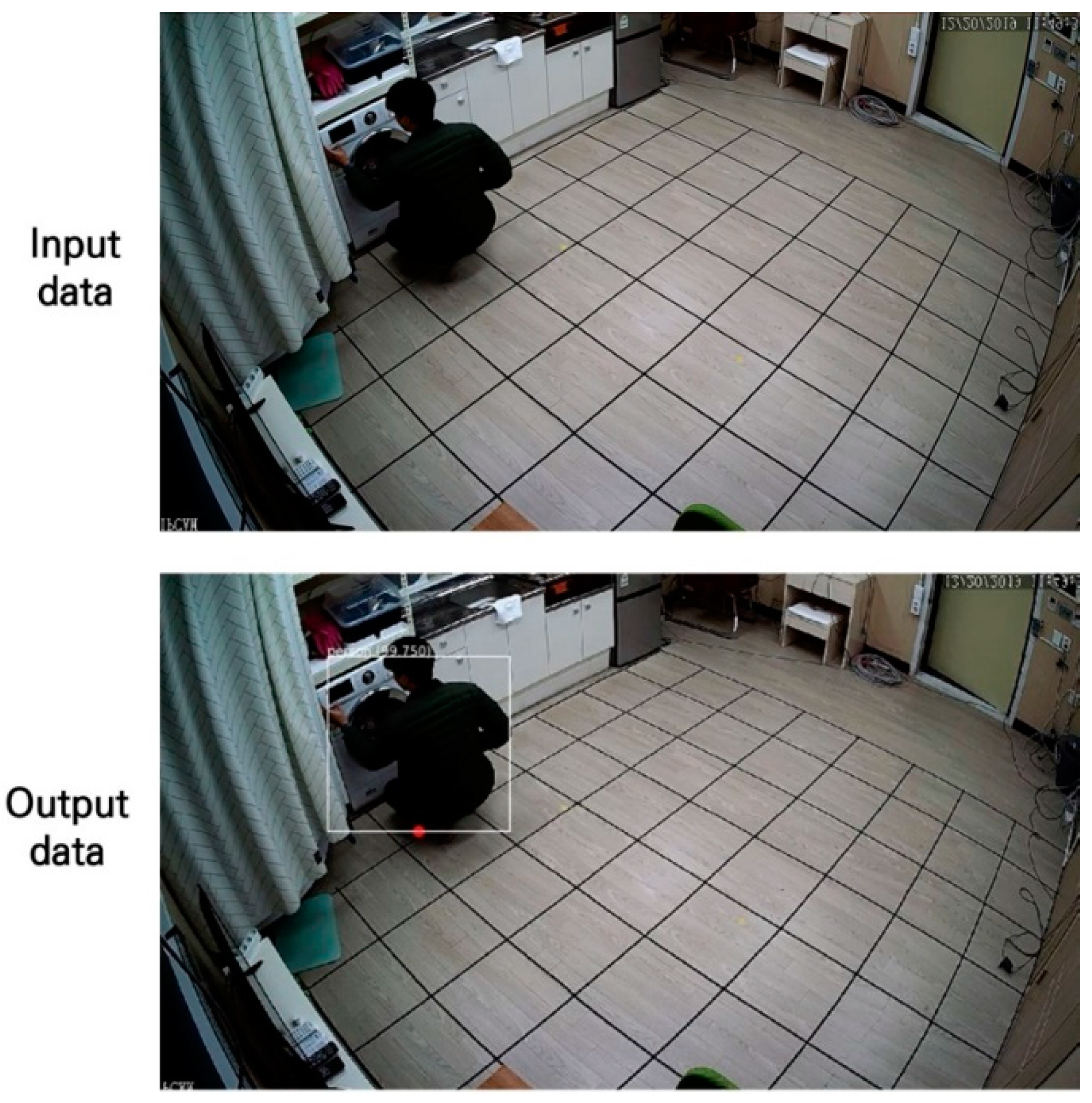
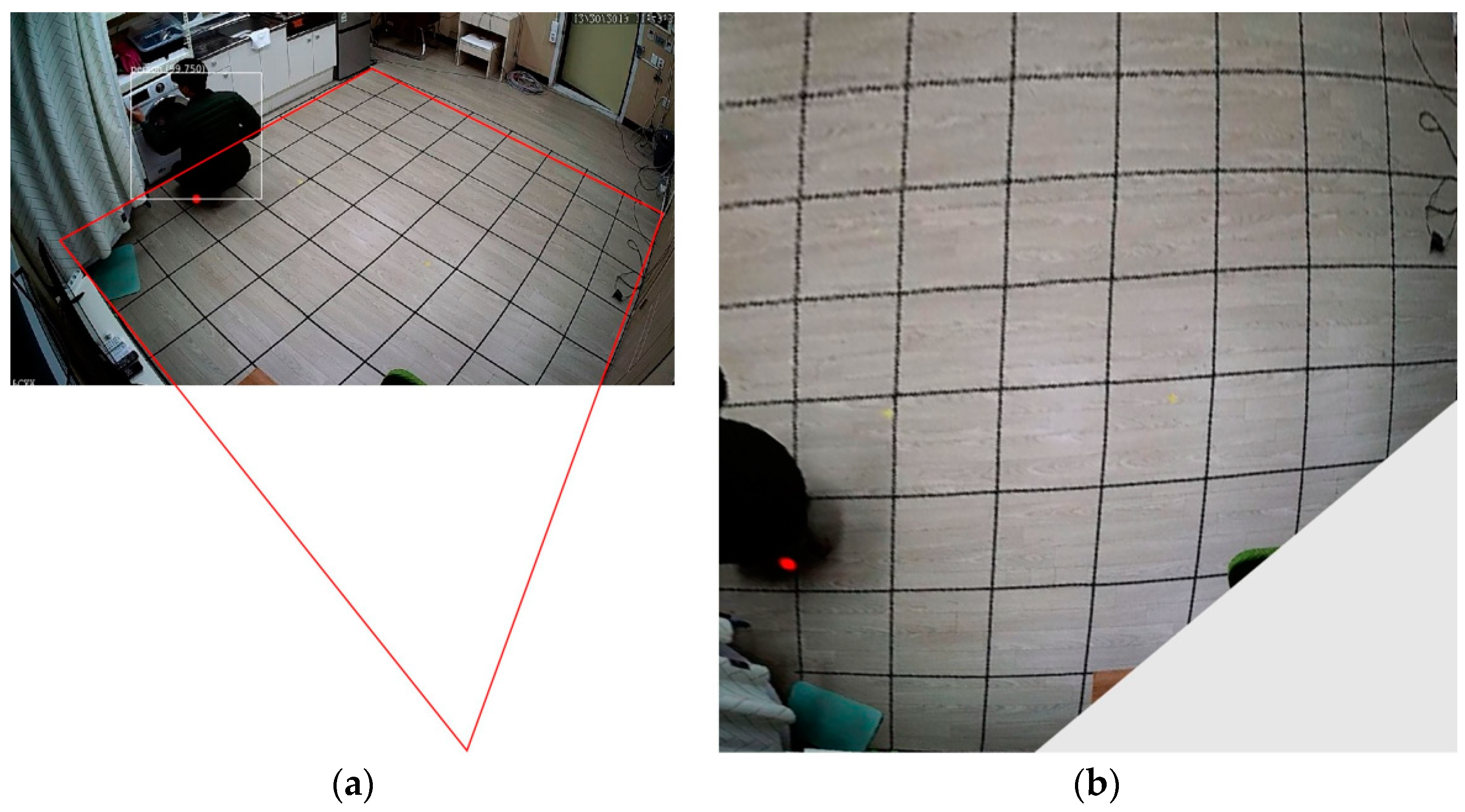


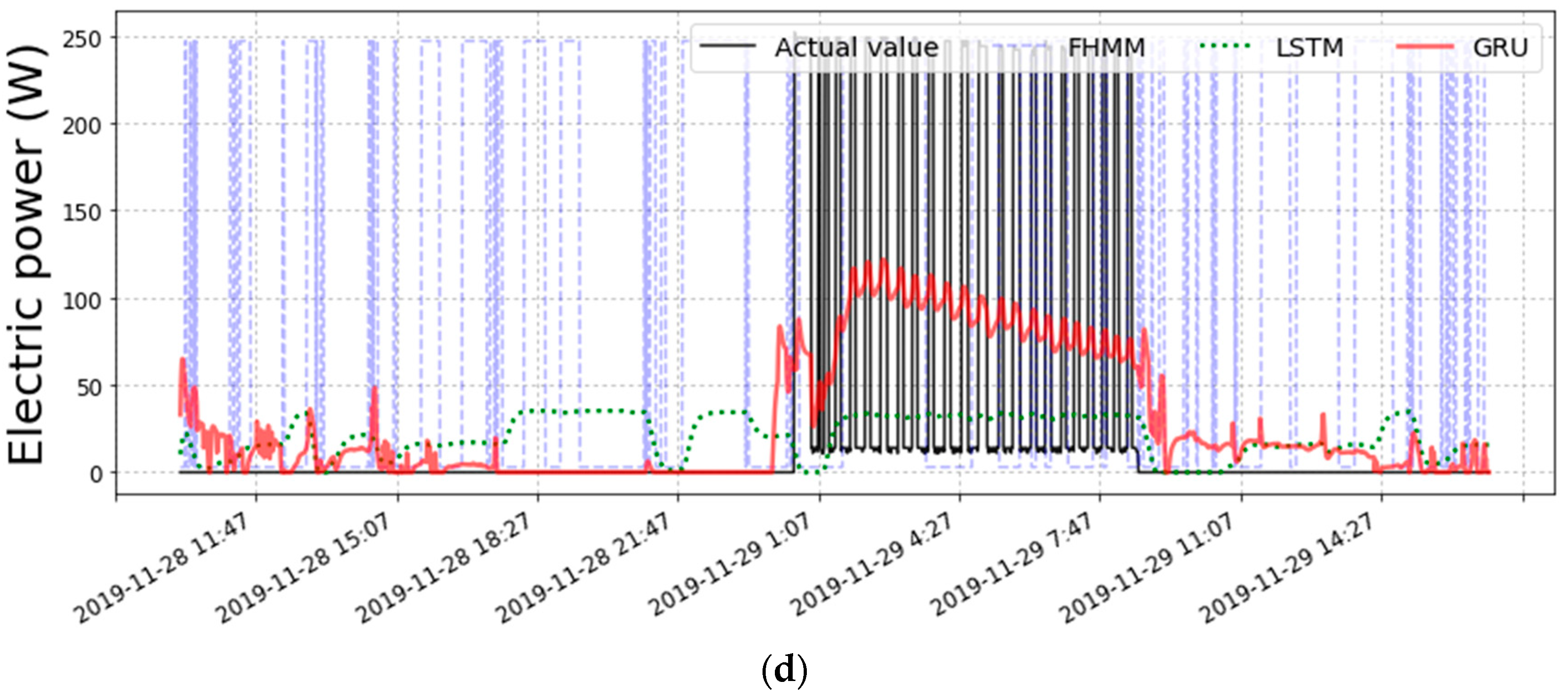

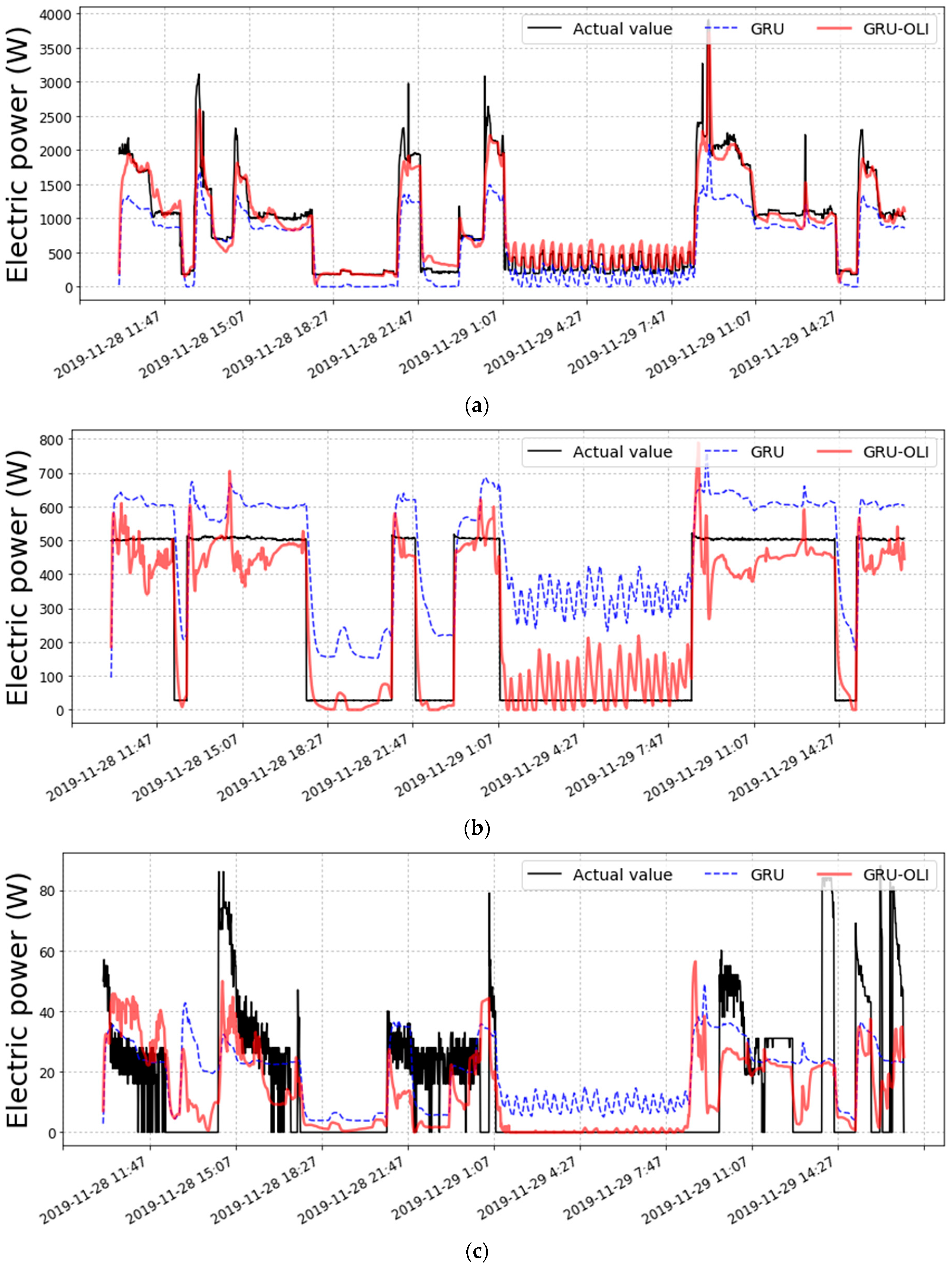
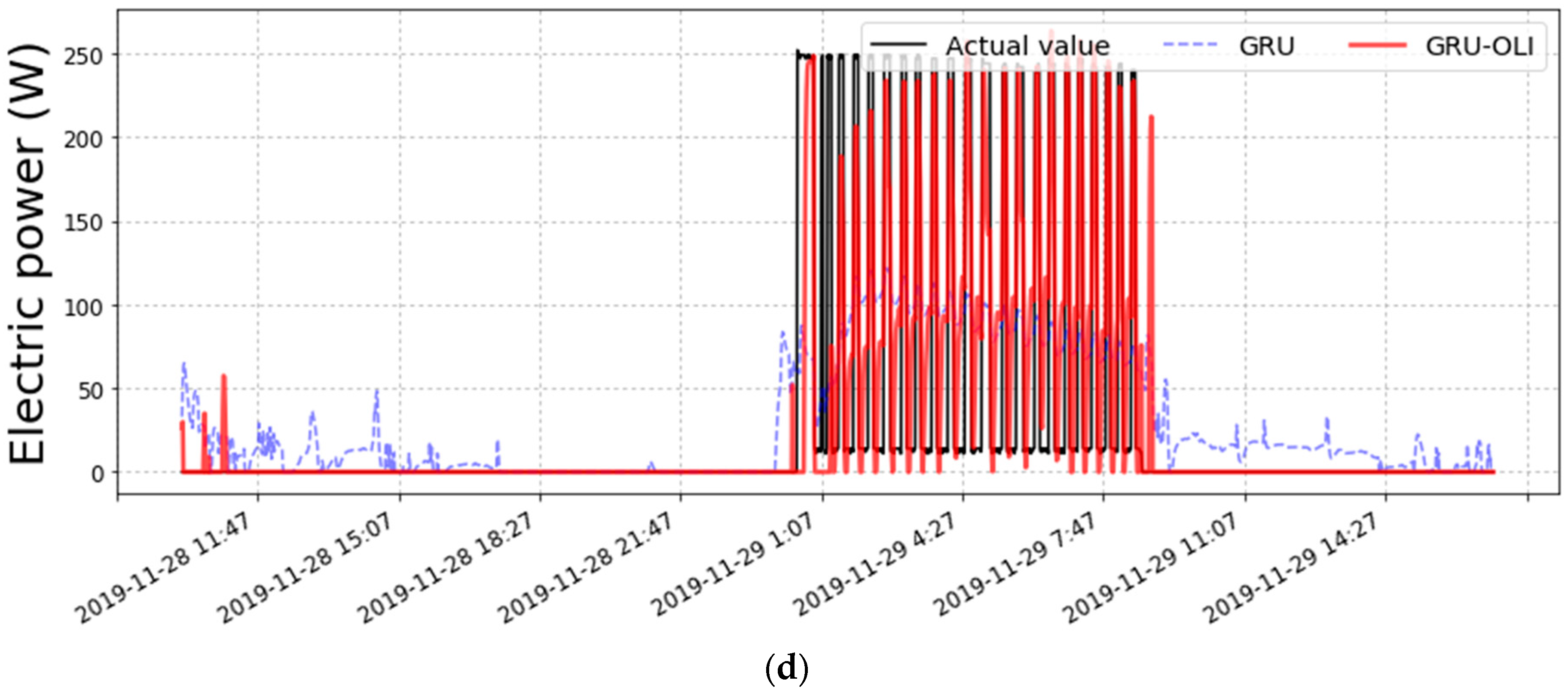
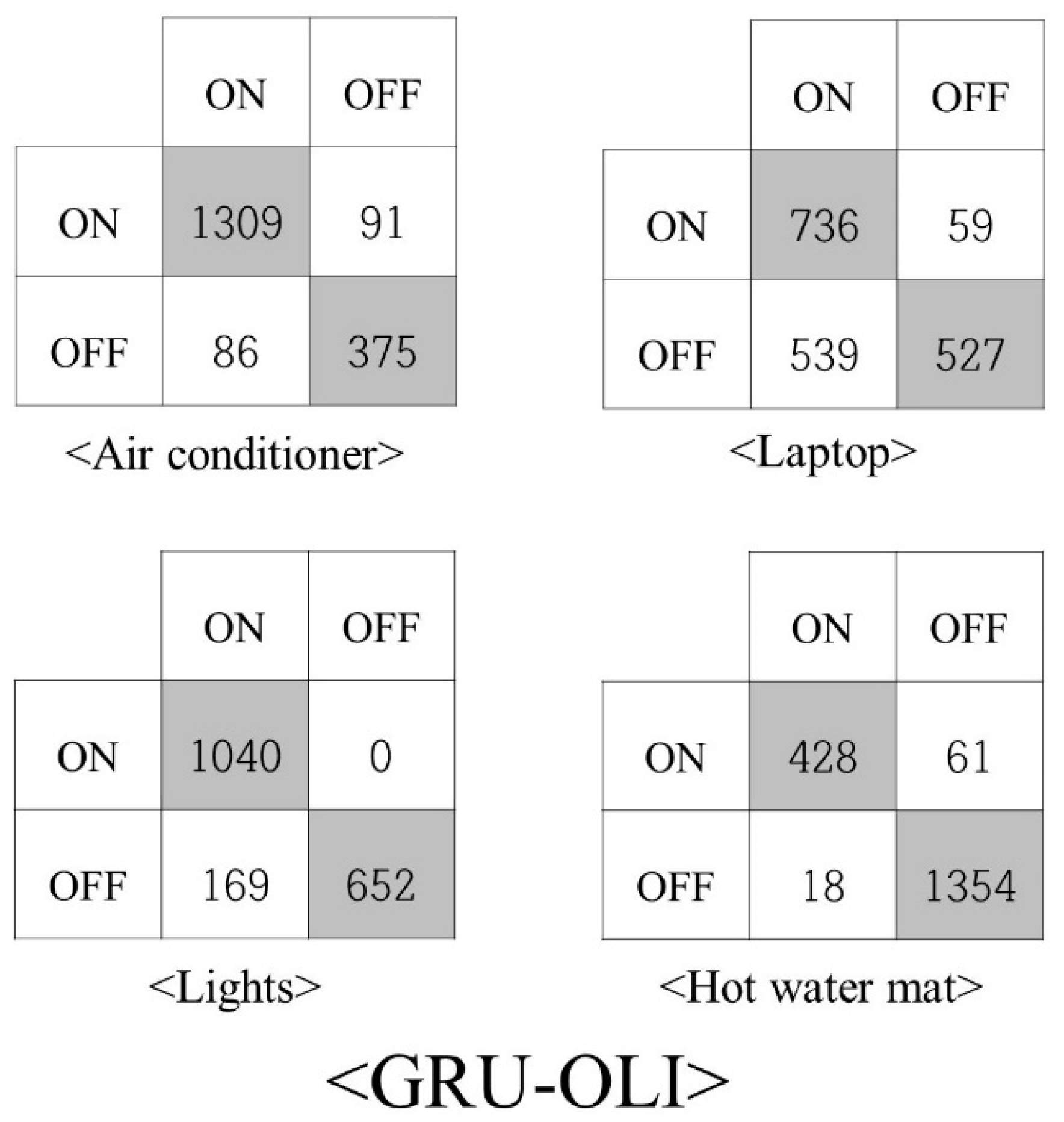
| Number | Appliance |
|---|---|
| 1 | Desktop |
| 2 | Fridge |
| 3 | Air conditioner |
| 4 | Lights |
| 5 | Energy recovery ventilation (ERV) |
| 6 | Washer |
| 7 | Microwave |
| 8 | TV |
| 9 | Laptop |
| 10 | Rice cooker |
| 11 | Hot water mat |
| 12 | Hair dryer |
| 13 | Humidifier |
| 14 | Air cleaner |
| Dataset | Period | Proportion |
|---|---|---|
| Training data | 2019.11.25 09:39:00~2019.11.28 09:59:00 | 70% (4341 rows) |
| Test data | 2019.11.28 10:00:00~2019.11.29 17:00:00 | 30% (1861 rows) |
| Hidden Layers | Hidden Nodes | Batch Size | Activation Function | Optimizer | Epoch |
|---|---|---|---|---|---|
| 3 | 64, 64, 64 | 64 | RELU and ELU | ADAM | 200 |
| Appliances | Actual Value (kWh) | FHMM (kWh) | LSTM (kWh) | GRU (kWh) |
|---|---|---|---|---|
| Air conditioner | 27.96 | 9.90 | 15.43 | 19.66 |
| Lights | 9.12 | 8.16 | 12.69 | 14.50 |
| Desktop | 2.52 | 2.19 | 2.18 | 2.59 |
| ERV | 2.03 | 0.87 | 2.01 | 1.81 |
| Hot water mat | 0.81 | 3.57 | 0.64 | 0.92 |
| Laptop | 0.46 | 0.53 | 0.51 | 0.57 |
| Fridge | 0.40 | 0.71 | 0.44 | 0.46 |
| Washer | 0.27 | 12.72 | 1.15 | 0.90 |
| Air cleaner | 0.27 | 0.16 | 0.01 | 0.24 |
| Rice cooker | 0.08 | 3.79 | 0.11 | 0.35 |
| Microwave | 0.07 | 0.06 | 0.68 | 0.24 |
| Hair dryer | 0.04 | 0.19 | 0.12 | 1.16 |
| TV | 0.02 | 0.36 | 0.03 | 0.02 |
| Humidifier | 0 | 0.32 | 0.20 | 0.14 |
| Appliances | FHMM | LSTM | GRU | |||
|---|---|---|---|---|---|---|
| MAE | RMSE | MAE | RMSE | MAE | RMSE | |
| Air conditioner | 595.68 | 855.72 | 432.01 | 623.80 | 284.35 | 378.44 |
| Lights | 85.79 | 200.83 | 161.92 | 203.98 | 178.33 | 213.26 |
| Desktop | 10.92 | 14.66 | 10.78 | 11.23 | 12.72 | 12.92 |
| ERV | 38.39 | 48.26 | 6.36 | 7.70 | 7.24 | 7.68 |
| Hot water mat | 119.96 | 169.58 | 37.50 | 71.17 | 33.70 | 58.26 |
| Laptop | 18.03 | 26.28 | 14.89 | 19.11 | 14.46 | 18.71 |
| Fridge | 19.80 | 30.81 | 19.61 | 21.79 | 19.78 | 21.75 |
| Washer | 401.43 | 824.36 | 40.59 | 98.38 | 31.07 | 97.25 |
| Air cleaner | 5.51 | 8.14 | 2.49 | 5.14 | 3.03 | 4.93 |
| Rice cooker | 121.40 | 172.77 | 6.02 | 30.70 | 13.08 | 30.40 |
| Microwave | 4.39 | 51.69 | 24.23 | 58.61 | 10.12 | 52.46 |
| Hair dryer | 7.31 | 42.43 | 5.10 | 42.33 | 38.46 | 75.77 |
| TV | 11.79 | 18.48 | 1.62 | 4.50 | 1.27 | 4.60 |
| Humidifier | 10.39 | 15.12 | 6.52 | 6.53 | 4.42 | 5.47 |
| Average | 103.63 | 177.08 | 54.97 | 86.07 | 46.57 | 70.14 |
| Appliances | FHMM | LSTM | GRU | |||
|---|---|---|---|---|---|---|
| Accuracy | F1-Score | Accuracy | F1-Score | Accuracy | F1-Score | |
| Air conditioner | 0.70 | 0.69 | 0.84 | 0.79 | 0.89 | 0.85 |
| Lights | 0.82 | 0.82 | 0.88 | 0.87 | 0.89 | 0.89 |
| Desktop | 0.53 | 0.46 | 1.00 | 1.00 | 1.00 | 1.00 |
| ERV | 0.38 | 0.28 | 0.99 | 0.50 | 0.99 | 0.50 |
| Hot water mat | 0.56 | 0.52 | 0.46 | 0.46 | 0.52 | 0.52 |
| Laptop | 0.62 | 0.61 | 0.59 | 0.58 | 0.60 | 0.59 |
| Fridge | 0.61 | 0.58 | 0.41 | 0.41 | 0.41 | 0.41 |
| Washer | 0.82 | 0.65 | 0.84 | 0.67 | 0.86 | 0.69 |
| Air cleaner | 0.55 | 0.47 | 0.48 | 0.39 | 0.34 | 0.33 |
| Rice cooker | 0.51 | 0.36 | 0.49 | 0.33 | 0.51 | 0.36 |
| Microwave | 0.99 | 0.50 | 0.99 | 0.50 | 0.99 | 0.50 |
| Hair dryer | 0.99 | 0.50 | 0.50 | 0.34 | 0.50 | 0.34 |
| TV | 0.59 | 0.39 | 0.97 | 0.49 | 0.99 | 0.50 |
| Humidifier | 0.53 | 0.35 | 0.54 | 0.35 | 0.54 | 0.35 |
| Average | 0.66 | 0.51 | 0.71 | 0.55 | 0.72 | 0.56 |
| Appliances | Actual Value (kWh) | FHMM (kWh) | LSTM (kWh) | GRU (kWh) | GRU–OLI (kWh) |
|---|---|---|---|---|---|
| Air conditioner | 27.96 | 9.90 | 15.43 | 19.66 | 27.47 |
| Lights | 9.12 | 8.16 | 12.69 | 14.50 | 8.87 |
| Desktop | 2.52 | 2.19 | 2.18 | 2.59 | 2.50 |
| ERV | 2.03 | 0.87 | 2.01 | 1.81 | 2.04 |
| Hot water mat | 0.81 | 3.57 | 0.64 | 0.92 | 0.86 |
| Laptop | 0.46 | 0.53 | 0.51 | 0.57 | 0.44 |
| Fridge | 0.40 | 0.71 | 0.44 | 0.46 | 0.39 |
| Washer | 0.27 | 12.72 | 1.15 | 0.90 | 0.31 |
| Air cleaner | 0.27 | 0.16 | 0.01 | 0.24 | 0.25 |
| Rice cooker | 0.08 | 3.79 | 0.11 | 0.35 | 0.32 |
| Microwave | 0.07 | 0.06 | 0.68 | 0.24 | 0.16 |
| Hair dryer | 0.04 | 0.19 | 0.12 | 1.16 | 0.95 |
| TV | 0.02 | 0.36 | 0.03 | 0.02 | 0.02 |
| Humidifier | 0 | 0.32 | 0.20 | 0.14 | 0.08 |
| Appliances | GRU | GRU–OLI | ||
|---|---|---|---|---|
| MAE | RMSE | MAE | RMSE | |
| Air conditioner | 284.35 | 378.44 | 131.35 | 215.35 |
| Lights | 178.33 | 213.26 | 55.79 | 74.77 |
| Desktop | 12.72 | 12.92 | 4.57 | 5.62 |
| ERV | 7.24 | 7.68 | 4.20 | 5.24 |
| Hot water mat | 33.70 | 58.26 | 15.55 | 40.13 |
| Laptop | 14.46 | 18.71 | 10.52 | 12.59 |
| Fridge | 19.78 | 21.75 | 17.43 | 22.23 |
| Washer | 31.07 | 97.25 | 30.79 | 92.63 |
| Air cleaner | 3.03 | 4.93 | 2.39 | 4.94 |
| Rice cooker | 13.08 | 30.40 | 12.42 | 28.13 |
| Microwave | 10.12 | 52.46 | 7.56 | 51.09 |
| Hair dryer | 38.46 | 75.77 | 31.98 | 61.23 |
| TV | 1.27 | 4.60 | 1.11 | 4.30 |
| Humidifier | 4.42 | 5.47 | 2.85 | 3.68 |
| Average | 46.57 | 70.14 | 23.47 | 44.42 |
| Appliances | GRU | GRU-OLI | ||
|---|---|---|---|---|
| Accuracy | F1-Score | Accuracy | F1-Score | |
| Air conditioner | 0.89 | 0.85 | 0.93 | 0.90 |
| Lights | 0.89 | 0.89 | 0.91 | 0.91 |
| Desktop | 1.00 | 1.00 | 1.00 | 1.00 |
| ERV | 0.99 | 0.50 | 1.00 | 0.50 |
| Hot water mat | 0.52 | 0.52 | 0.96 | 0.94 |
| Laptop | 0.60 | 0.59 | 0.67 | 0.65 |
| Fridge | 0.41 | 0.41 | 0.39 | 0.39 |
| Washer | 0.86 | 0.69 | 0.89 | 0.72 |
| Air cleaner | 0.34 | 0.33 | 0.47 | 0.43 |
| Rice cooker | 0.51 | 0.36 | 0.51 | 0.36 |
| Microwave | 0.99 | 0.50 | 0.98 | 0.50 |
| Hair dryer | 0.50 | 0.34 | 0.50 | 0.34 |
| TV | 0.99 | 0.50 | 0.97 | 0.49 |
| Humidifier | 0.54 | 0.35 | 0.81 | 0.45 |
| Average | 0.72 | 0.56 | 0.79 | 0.61 |
| Value | FHMM | GRU-OLI (Suggested Method) | ||||||
|---|---|---|---|---|---|---|---|---|
| MAE | RMSE | Accuracy | F1-Score | MAE | RMSE | Accuracy | F1-Score | |
| Average | 103.63 | 177.08 | 0.66 | 0.51 | 23.47 | 44.42 | 0.79 | 0.61 |
Disclaimer/Publisher’s Note: The statements, opinions and data contained in all publications are solely those of the individual author(s) and contributor(s) and not of MDPI and/or the editor(s). MDPI and/or the editor(s) disclaim responsibility for any injury to people or property resulting from any ideas, methods, instructions or products referred to in the content. |
© 2023 by the authors. Licensee MDPI, Basel, Switzerland. This article is an open access article distributed under the terms and conditions of the Creative Commons Attribution (CC BY) license (https://creativecommons.org/licenses/by/4.0/).
Share and Cite
Lee, M.-H.; Moon, H.-J. Nonintrusive Load Monitoring Using Recurrent Neural Networks with Occupants Location Information in Residential Buildings. Energies 2023, 16, 3688. https://doi.org/10.3390/en16093688
Lee M-H, Moon H-J. Nonintrusive Load Monitoring Using Recurrent Neural Networks with Occupants Location Information in Residential Buildings. Energies. 2023; 16(9):3688. https://doi.org/10.3390/en16093688
Chicago/Turabian StyleLee, Myeung-Hun, and Hyeun-Jun Moon. 2023. "Nonintrusive Load Monitoring Using Recurrent Neural Networks with Occupants Location Information in Residential Buildings" Energies 16, no. 9: 3688. https://doi.org/10.3390/en16093688
APA StyleLee, M.-H., & Moon, H.-J. (2023). Nonintrusive Load Monitoring Using Recurrent Neural Networks with Occupants Location Information in Residential Buildings. Energies, 16(9), 3688. https://doi.org/10.3390/en16093688






